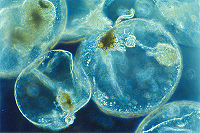Noctiluca scintillans
For the course duration, the article is closed to outside editing. Of course you can always leave comments on the discussion page. The anticipated date of course completion is May 21, 2009. One month after that date at the latest, this notice shall be removed. Besides, many other Citizendium articles welcome your collaboration! |
| Noctiluca scintillans | ||||||||
|---|---|---|---|---|---|---|---|---|
 | ||||||||
| Scientific classification | ||||||||
|
Description and Significance
Noctiluca scintillans, also known as sea sparkles, are single-celled dinoflagellates that exhibit bioluminescence. They are free-living marine plankton, which range between 200-2000 micrometers in diameter. They are mostly found in estuaries and other coastal regions and can be found in both warm and cold waters. N. Scintillans are heterotrophic and non-photosynthetic, meaning they receive their carbon from organic compounds and receive their energy through the ingestion of organic substances. They don’t have any chloroplasts so, their cytoplasm is relatively clear. Noctiluca scintillans are non-motile, even though they possess a flagellum, and only move vertically by changing their buoyancy using gas vacuoles. N. Scintillans can reproduce asexually, by binary fission, and sexually, using isogametes through a diplontic lifecycle.
Genome and Structure
Cell Structure and Metabolism
Noctiluca scintillans has a round, balloon-like, body shape and is unarmored, meaning it does not have a protective shell. Since they do not photosynthesize, they don’t have chloroplasts and thus are fairly clear. The red and green color usually associated with this species, in the red and green tides, are due to the pigments of the photosynthetic symbionts within the vacuoles of N. scintillans and not the species itself. N. scintillans has a ventral groove that runs through their bodies which contains the flagellum, a tooth and a tentacle.
Noctiluca scintillans is a phagotrophic species with many food vacuoles found throughout their cytoplasm. They engulf other marine species such as diatoms, fish eggs, and certain bacteria and then digest them in these food vacuoles. N. scintillans also contain gas vacuoles, which are filled with ammonia gas, that allow them to control their buoyancy.